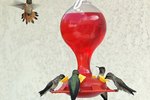In the wild, a hummingbird’s diet consists mostly of flower nectar and small, soft insects. However, more people are taking an interest in the diminutive avian and putting out hummingbird feeders and adding sugar water to the bird's diet. Because of this menu item, it is important for the human feeder to remember some important rules when dealing with the small and delicate stomach of the hummingbird.
The Facts
The hummingbird diet is not specific to the types of sugars that can be metabolized. According to hummingbirds.net, “There is no proven advantage in using, say, fructose instead of sucrose (cane or beet sugar)." The basic hummingbird feeder recipe consists only of one part sugar to four parts water. Heat the water to a rolling boil and then add the sugar. It is not necessary to add any colored dyes to this mixture, which can be stored in the refrigerator for about two weeks.
Warning
Never put a honey mixture inside of a hummingbird feeder. The honey, when mixed with water will ferment, which will cause hummingbirds to develop candidiasis (Candida albicans), more commonly known as thrush. Thrush can make it difficult or impossible for hummingbirds to feed, leading to starvation or even death. Oftentimes, this can be treated professionally with antibiotics.
Significance
Before honey is the liquid gold we love to drizzle over biscuits or mix in our tea, it is nectar. This nectar contains elevated amounts of water and natural yeasts. Bees work together to create enough air flow in the hive with their wings to evaporate the excess water from the nectar. This evaporation halts fermentation. So adding water back to honey would be reanimating the fermentation process, creating a health hazard for the hummingbirds.
Time Frame
Do clean your feeder. Maintenance of a feeder is fairly easy. When it is time to refill, rinse the feeder with hot tap water; soap is not necessary. However, a baby bottle brush will come in handy to clean in between the hard to reach places. Check the feeder for mold, should there be any mold present, soak the feeder in a bleach and water solution. A clean feeder makes for happy hummingbirds that are likely to become regular feeders.
Considerations
According to the "Journal of Wildlife Diseases," "other hummingbird ailments include diseases such as aspergillosis, salmonellosis, and mycobacteriosis have been documented." The most common description of Candidiasis in hummingbirds is an extended tongue and open mouth. It is also reasonable to assume that the larger the congregation of hummingbirds feeding at the same station, the higher the chance of spreading infection. Sanitize your feeder should you see a sick or dead bird and remember, only professionals can lawfully treat wild birds. Avianweb.com offers some valuable advice, "If you find a diseased bird, it is best to report it to your state, provincial or local wildlife agency."
References
Writer Bio
Kimberly Laurent has been writing professionally since 2004. She has been a staff writer for "The Courier," and is currently a contributing writer on eHow, where her specialty topics include animals and beauty. Laurent is earning a bachelor's degree in English literature at Columbus State University.


